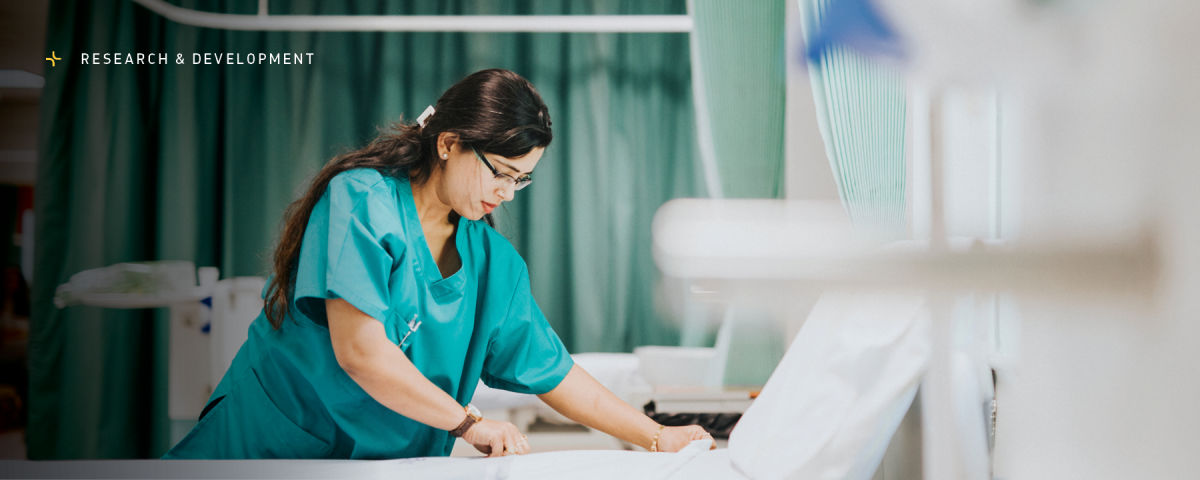In critical care, design matters. It always has. From light and acoustics to thermal stability and spatial layout, the built environment of the intensive care unit (ICU) can shape patient experience, staff wellbeing, and even recovery outcomes. Yet our most recent study offers a sobering insight: even in well-designed ICU rooms, environmental conditions often fail to support sleep, one of the most basic physiological needs.
This article marks the third and final instalment in a multi-year research program investigating environmental disruption in critical care. While our previous publications focused on design modelling and multidomain environmental analysis, this final paper Environmental Non-compliance in the ICU reveals a crucial insight: some problems cannot be designed out. Instead, they demand something more integrated, more behavioural, and, ultimately, more systemic.
The hidden risks of a well-functioning ICU
Intensive care is built on precision and vigilance. Monitors beep, alarms sound, staff intervene, and lives are saved. But in the background, the environment often works against the very recovery it seeks to support.
Our study tracked environmental exposures to sound, light, and temperature in a standard single ICU room over 11 days, across four patient admissions. Using continuous monitoring, we benchmarked the real-time environment against evidence-based thresholds for sleep and circadian regulation.
The results:
- Sound exceeded sleep-supportive levels more than 97% of the time.
- Light levels were consistently too low during the day and too high at night.
- Temperature remained static, with no diurnal variation, undermining circadian cues.
More importantly, these disruptions didn’t occur in isolation. They overlapped, compounding the physiological burden. During occupied periods, compliance with all three thresholds occurred just 0.5% of the time.
This workflow-generated exposure requires a different kind of solution.
Beyond the drawing board: Latent iatrogenic risk
What we uncovered is a form of latent iatrogenic risk, a harm not from error or malfunction, but from the ordinary, everyday functioning of a complex care environment. Doors left ajar, lights left on, HVAC systems locked to infection-control specifications. All of these create environmental conditions that actively disrupt sleep and recovery. Yet these conditions are rarely measured, let alone managed.
Here lies the tension: healthcare contexts cannot rely on design alone to solve behavioural problems. Nor can we expect clinicians to mitigate risks they can’t see. There is no vitals dashboard for ambient light levels or sound burden. And in the absence of visibility, there is no accountability.
Designers and Clinicians: Two Halves of the Same Equation
This study closes the loop on a question we’ve been circling for years: Can we build better healing environments? The answer is yes, but not by design alone.
We consulted with Gaye McKean, a senior healthcare facility designer, to stress-test our findings. Her insights were clear and grounded: most ICU rooms are served by centralised HVAC systems, governed by infection control and energy efficiency—not by patient comfort. Individual temperature control? Rare. Tuneable circadian lighting? Infrequently used. Operable windows? Non-existent.
These constraints are not flaws in design; they are features of highly constrained clinical environments and legacy infrastructure. But they highlight the need for protocol-based solutions that work in concert with design, not in parallel or afterthought.
A Framework for Symbiosis
Rather than calling for another round of architectural innovation, our study advocates for a new kind of thinking: environmental governance as clinical governance.
Some of our key recommendations include:
- Scheduled quiet times, aligned with circadian physiology, supported by alarm management and behavioural prompts.
- Automated lighting routines that simulate dawn and dusk, without relying on staff intervention.
- Thermal assessment protocols during nursing rounds, guiding appropriate bedding, fan use (where permissible), or targeted patient allocation.
- Environmental dashboards, integrated into the clinical interface, showing ambient sound, light, and temperature in real time.
In short, we propose that ICU environments be treated not just as static enclosures, but as active contributors to care and governed accordingly.
Implications for design practice
So, what does this mean for the design community?
Firstly, it reinforces the need for post-occupancy evaluations (POEs) that include behavioural data and real-time environmental metrics, not just spatial audits. Secondly, it underscores that high-performance design must be embedded within a governance framework. If a room has tuneable lighting but no protocol for its use, its benefits may be lost entirely.
Finally, it invites a different kind of collaboration between designers, clinicians, engineers, and governance teams so that environmental conditions become part of the therapeutic model, not an incidental backdrop.
From insight to action
This is the closing paper in a trilogy:
- The first explored design-led acoustic modelling in ICU settings (Jonescu et al., 2024).
- The second examined how light, sound, and temperature interact to influence wellbeing (Jonescu et al., 2025).
- This third study reframes these conditions as clinically relevant risks, measurable, modifiable, and manageable, if brought within the remit of care.
For healthcare clients, the takeaway is clear: investing in high-quality design must be matched by investment in policy, practice, and protocol. Without both, even the best-designed environments will fall short of their healing potential.
From insight to implementation: Future research directions
While this study highlights the feasibility of protocol-based solutions, it also opens new avenues for inquiry, including patient and next of kin perspectives.
One of the most promising areas for future research is the development of real-time environmental dashboards, interfaces that integrate light, noise, and temperature data alongside clinical vitals. These dashboards could empower ICU teams with visible, actionable feedback, transforming passive environmental conditions into measurable clinical variables.
Complementary research could investigate the design and efficacy of visual reminders or ambient alerts. For example, subtle colour-coded lighting strips, bedside icons, or control panel indicators could provide staff with intuitive cues when thresholds are exceeded without adding to cognitive burden. Exploring how human factors, interface design, and clinician responsiveness to environmental risk will be critical.
Moreover, studies that assess how automated prompts and preset environmental modes (e.g. “night mode” lighting dimmers, quiet-time protocols) affect patient outcomes could help shape policy and procurement decisions in future ICU builds or refurbishments.
The broader challenge is the opportunity to treat environmental governance as a systems design problem, integrating architecture, technology, and workflow into a unified care strategy.
Conclusion: A shared responsibility
Recovery in the ICU depends not only on clinical expertise but also on the conditions patients are immersed in. Ambient noise, light rhythms, and thermal stability all become powerful therapeutic agents when deliberately managed as part of care.
This study shows that the future of healthcare design lies in the intentional integration of architecture and operations. Protocols need design. Design needs protocols. Neither can do it alone.
For clients and partners in healthcare delivery, it’s an invitation to co-create environments where healing is supported not just by walls and systems, but by culture, awareness, and shared responsibility.








